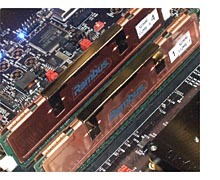Rambus unveils multi-threaded DRAM tech
Los Altos (CA) - Processing multiple threads is not just for processors anymore: Rambus today announced an architecture extension for DRAM that offers up to 4x memory performance in such applications as 3D graphics, video imaging, network routing and switching.
Slowly but surely the days of the single-threaded computer world disappears. And the capability to work on multiple tasks at the same time will not be limited to dual-core and hyper-threaded processors or dual graphics chips. After years with a questionable future, Rambus has been putting out some interesting innovations with the most recent being multi-threading or micro-threading as Rambus calls it, in DRAM.
There were not many details about the technology available yet, but the company claims that especially graphic heavy applications will benefit from cutting data chunks into smaller portions. Lab results showed up to four times greater performance when compared to a traditional DRAM in applications such as 3D graphics, advanced video imaging, and network routing and switching, Rambus said.
As is the case with Intel's Hyperthreading, applications cannot take advantage of the separate data streams right away, but require code modifications from software developers. Woo said that the threading technology allows to be either switched on or off and the software integration of DRAM threading support would only require a "small amount of work."
The core functionality of based on the idea to process smaller amounts of data but still take advantage of the high bandwidth of today's memory architecture. Rambus technology allows grabbing only the minimal amount of data required and processing at least two threads at the same time which results in a more efficient use of the available bandwidth. "In graphics, you need the high bandwidth, but you actually want to fetch smaller chunks of data for smaller textured polygons or triangles," Woo said.
According to Rambus, GDDR SDRAM being used in a 3D application can deliver between 50 and 125 million triangles per second. If the same GDDR SDRAM were to be enhanced with micro-threading, the rate of delivered triangles would increase to between 100 and 500 million triangles per second.
While the technology will be available to DRAM modules in general, micro-threading looks like a perfect standard feature for Rambus' XDR technology which has the potential to succeed GDDR memory in graphics cards in 2006 or 2007. Woo declined to comment, if XDR will be made available by default in this memory technology.
Get Tom's Hardware's best news and in-depth reviews, straight to your inbox.

Wolfgang Gruener is an experienced professional in digital strategy and content, specializing in web strategy, content architecture, user experience, and applying AI in content operations within the insurtech industry. His previous roles include Director, Digital Strategy and Content Experience at American Eagle, Managing Editor at TG Daily, and contributing to publications like Tom's Guide and Tom's Hardware.
